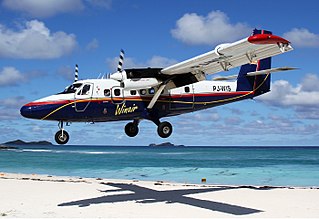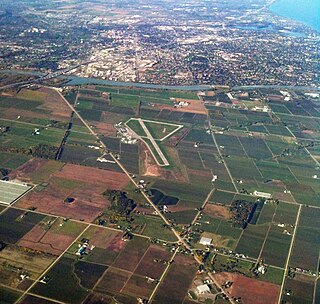
Davis–Monthan Air Force Base is a United States Air Force base 5 miles southeast of downtown Tucson, Arizona. It was established in 1925 as Davis–Monthan Landing Field. The host unit for Davis–Monthan AFB is the 355th Wing assigned to Twelfth Air Force (12AF), part of Air Combat Command (ACC). The base is best known as the location of the Air Force Materiel Command's 309th Aerospace Maintenance and Regeneration Group, the aircraft boneyard for all excess military and U.S. government aircraft and aerospace vehicles.

Search and rescue (SAR) is the search for and provision of aid to people who are in distress or imminent danger. The general field of search and rescue includes many specialty sub-fields, typically determined by the type of terrain the search is conducted over. These include mountain rescue; ground search and rescue, including the use of search and rescue dogs; urban search and rescue in cities; combat search and rescue on the battlefield and air-sea rescue over water.

Swissair Flight 111 was a scheduled international passenger flight from John F. Kennedy International Airport in New York City, United States, to Cointrin Airport in Geneva, Switzerland. This flight was also a codeshare flight with Delta Air Lines. On 2 September 1998, the McDonnell Douglas MD-11 performing this flight, registration HB-IWF, crashed into the Atlantic Ocean southwest of Halifax Stanfield International Airport at the entrance to St. Margarets Bay, Nova Scotia. The crash site was 8 kilometers from shore, roughly equidistant from the tiny fishing and tourist communities of Peggy's Cove and Bayswater. All 229 passengers and crew on board the MD-11 were killed, making the crash the deadliest McDonnell Douglas MD-11 accident in aviation history.

The Snowbirds, officially known as 431 Air Demonstration Squadron, are the military aerobatics flight demonstration team of the Royal Canadian Air Force. The team is based at 15 Wing Moose Jaw near Moose Jaw, Saskatchewan. The Snowbirds' official purpose is to "demonstrate the skill, professionalism, and teamwork of Canadian Forces personnel". The team also provides a public relations and recruiting role, and serves as an aerial ambassador for the Canadian Armed Forces. The Snowbirds are the first Canadian air demonstration team to be designated as a squadron.

The de Havilland Canada DHC-6 Twin Otter, currently marketed as the Viking Air DHC-6 Twin Otter, is a Canadian 19-passenger STOL utility aircraft developed by de Havilland Canada, which produced the aircraft from 1965 to 1988; Viking Air purchased the type certificate, then restarted production in 2008. The aircraft's fixed tricycle undercarriage, STOL capabilities, twin turboprop engines and high rate of climb have made it a successful commuter passenger airliner as well as a cargo and medical evacuation aircraft. In addition, the Twin Otter has been popular with commercial skydiving operations, and is used by the United States Army Parachute Team and the United States Air Force's 98th Flying Training Squadron.
A group is a military unit or a military formation that is most often associated with military aviation.

The Royal Canadian Air Force is the air and space force of Canada. Its role is to "provide the Canadian Forces with relevant, responsive and effective airpower". The RCAF is one of three environmental commands within the unified Canadian Armed Forces. As of 2020, the Royal Canadian Air Force consists of 12,074 Regular Force and 1,969 Primary Reserve personnel, supported by 1,518 civilians, and operates 258 manned aircraft and 9 unmanned aerial vehicles. Lieutenant-General Al Meinzinger is the current commander of the Royal Canadian Air Force and chief of the Air Force Staff.

Transport Canada is the department within the Government of Canada responsible for developing regulations, policies and services of road, rail, marine and air transportation in Canada. It is part of the Transportation, Infrastructure and Communities (TIC) portfolio. The current Minister of Transport is Omar Alghabra. Transport Canada is headquartered in Ottawa, Ontario.
Crew resource management or cockpit resource management (CRM) is a set of training procedures for use in environments where human error can have devastating effects. CRM is primarily used for improving aviation safety and focuses on interpersonal communication, leadership, and decision making in aircraft cockpits. Its founder is David Beaty, a former Royal Air Force and a BOAC pilot who wrote "The Human Factor in Aircraft Accidents" (1969). Despite the considerable development of electronic aids since then, many principles he developed continue to prove effective.

The Canadian Coast Guard Auxiliary is a Canada-wide volunteer marine association dedicated to marine search and rescue (SAR) and the promotion of boating safety, through association with the Canadian Coast Guard under the auspices of Canada's National Search and Rescue Program.

The National Search and Rescue Program (NSP) is the name given by the Government of Canada to the collective search and rescue (SAR) activities in Canada. Until 2015, the NSP was administered by the National Search and Rescue Secretariat (NSS).

Universal Helicopters was a commercial helicopter company located in Newfoundland and Labrador, Canada. While operating primarily in Newfoundland and Labrador with operations sometimes extending into the Ungava Peninsula and the Arctic, Universal Helicopters held an International Operating Certificate and completed several contracts in Greenland.

St. Catharines/Niagara District Airport is a regional airport located in Niagara-on-the-Lake, Ontario, Canada. It is classified as an airport of entry by NAV CANADA and is staffed by the Canada Border Services Agency on a call out basis from the Queenston-Lewiston Bridge. CBSA officers at this airport currently can handle general aviation aircraft only, with no more than 15 passengers.

Marine Aircraft Group 42 was a United States Marine Corps reserve aviation unit based at Naval Air Station Atlanta, Georgia. Due to a re-organization within Marine aviation, MAG-42 was deactivated on 21 June 2008.

413 Transport and Rescue Squadron is an air force squadron of the Canadian Armed Forces. It was originally a flying boat squadron of the Royal Canadian Air Force during the Second World War. It currently operates the C-130 Hercules and the CH-149 Cormorant in transport plus search and rescue roles at CFB Greenwood.

United States Marine Corps Aviation is the aircraft arm of the United States Marine Corps. Marine Corps aviation units have a very different mission and operation than their ground counterparts and thus have their own history, traditions, terms, and procedures. Aviation units within the Marine Corps are assigned to support the Marine Air-Ground Task Force, as the aviation combat element, by providing six functions: assault support, antiair warfare, close air support, electronic warfare, control of aircraft and missiles, and aerial reconnaissance. The Corps operates both rotary-wing and fixed-wing aircraft mainly to provide transport and close air support to its ground forces. Other aircraft types are also used in a variety of support and special-purpose roles. All Marine Corps aviation falls under the influence of the Deputy Commandant for Aviation, whose job is to advise the Commandant of the Marine Corps in all matters relating to aviation, especially acquisition of new assets, conversions of current aircraft, maintenance, operation, and command.
The Joint Rescue Coordination Centre Victoria is a rescue coordination centre operated by the 1 Canadian Air Division and staffed by personnel of the Royal Canadian Air Force (RCAF) and the Canadian Coast Guard (CCG).
The Joint Rescue Coordination Centre Trenton is a rescue coordination centre operated by the Royal Canadian Air Force (RCAF) and the Canadian Coast Guard (CCG).

Air medical services is a comprehensive term covering the use of air transportation, aeroplane or helicopter, to move patients to and from healthcare facilities and accident scenes. Personnel provide comprehensive prehospital and emergency and critical care to all types of patients during aeromedical evacuation or rescue operations aboard helicopter and propeller aircraft or jet aircraft.

Air force ground forces and special forces are ground forces, and may include special operations units that are part of a nation's air force. Airmen assigned to such units may be trained, armed and equipped for ground combat and special operations.














